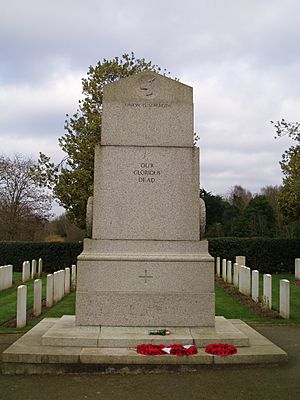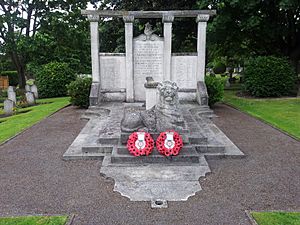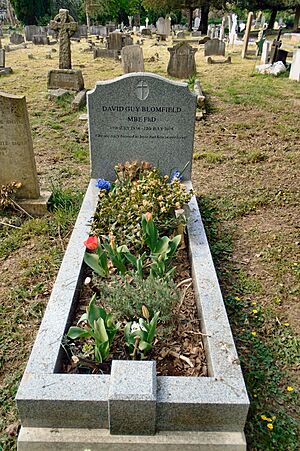Richmond Cemetery facts for kids

War graves and the South African War Memorial in Richmond Cemetery
|
|
| Lua error in Module:Location_map at line 420: attempt to index field 'wikibase' (a nil value). | |
| Details | |
|---|---|
| Established | 1786 |
| Location | |
| Country | England |
| Type | Active |
| Owned by | Richmond upon Thames London Borough Council |
| Size | 15 acres (6 hectares) |
Richmond Cemetery is a special burial ground in Richmond, England. It opened way back in 1786. The land for the cemetery was given by an Act of Parliament, which is a law passed by the government.
Over the years, the cemetery has grown a lot. It now covers 15 acres (about 6 hectares). This area used to be countryside before London became so big. The cemetery is next to Richmond Park on one side. It also touches East Sheen Cemetery on another side. They are so close now that they share a chapel for services.
Richmond Cemetery once had two chapels. One was for the Church of England, and the other was for other Christian groups called Nonconformists. Both were built in a style called Gothic revival. Today, both chapels are privately owned. One of them is now even outside the cemetery's walls because the boundaries changed.
Many important people are buried here. This includes 39 soldiers who died during the First World War. They were treated at the South African Hospital in Richmond Park. Also, many former service members from the nearby Royal Star and Garter Home are buried here.
A special monument called the Bromhead Memorial remembers these ex-servicemen. It lists the names of those not honored elsewhere. The South African soldiers are remembered by a cenotaph. This is a monument for people buried somewhere else. It was designed by Sir Edwin Lutyens. The Commonwealth War Graves Commission takes care of these war graves and the cenotaph.
Contents
Exploring Richmond Cemetery's Past
Richmond Cemetery was created after a law was passed in 1785. This law gave a piece of land called Pesthouse Common to the local Richmond council. This land used to belong to King George III.
At first, the burial ground was a small square, about 1.5 acres. It was divided into four sections by paths. Between 1865 and 1879, the cemetery grew much larger. It took over land between the original site and a workhouse. By 1894, it expanded even more to the north. Now, the cemetery is 15 acres, ten times its original size!
In 1873, the local vicar tried to build a wall. This wall would separate the ground for Church of England members from the ground for other faiths. But the community was very upset. One morning, the wall was found torn down. The vicar offered a reward to find out who did it, but no one was ever caught. The wall was never rebuilt.
Nature and Beauty at the Cemetery
The oldest part of the cemetery has many old trees. You can see yews, cypresses, and even some palm trees. When it was first built, the cemetery was in a very rural and pretty area. It still feels like a peaceful countryside churchyard today. One author, Darren Beach, says it has "a decidedly rural feel."
The Chapels of Richmond Cemetery
Richmond Cemetery originally had two chapels. One was for the Church of England, and the other for Nonconformists. Both were built in the Gothic revival style.
The Church of England chapel was built in 1875. It was designed by Sir Arthur Blomfield. This building is now a protected historic site. It is made mostly of Kentish ragstone with Bath stone decorations. Above the main door, there's an arch with a special message: "In the Garden was a new sepulchre, there laid they Jesus."
This chapel became run down, but it was fixed up in the 1990s. It is no longer used as a chapel. Instead, it now houses a children's nursery.
The Nonconformist chapel is north of the Anglican one. It was sold in 1992 and also restored. Its design is quite unique for a cemetery chapel in England. We don't know who the architect was. After the cemetery's boundary changed, this chapel is now outside the gates on Grove Road.
Beyond the old Anglican chapel are older burial grounds that are now closed. The area called "Richmond Old Burial Ground" is about four acres. Most burials there happened between 1856 and the First World War. Volunteers have photographed and recorded over 1000 graves there. They have found records of more than 2000 people.
Cemetery Neighbors: Richmond Park and East Sheen
To the east of the cemetery is Richmond Park. Only a narrow strip of land, about five meters wide, separates them. This strip is called the Freebord or "deer leap." The King owns it to protect the park's boundaries. It also allows access to check and fix the park wall.
Just to the north is East Sheen Cemetery. These two cemeteries are now connected. They form one large area of graves. A holly hedge still marks the original boundary between them. The chapel in East Sheen Cemetery is now used for services for both cemeteries. The Richmond upon Thames London Borough Council manages and maintains both cemeteries.
Richmond Cemetery is a protected area. It is part of the Metropolitan Open Land. It is also a conservation area, along with East Sheen Cemetery and Pesthouse Common.
Important Memorials and War Graves
Richmond Cemetery has several important memorials. One is a granite tomb for the engraver William Harvey. It used to be at a steep angle but has since settled. It has a carved palette design. The Prendergast family is remembered by two crosses with flower carvings.
Experts say that "Richmond Cemetery is unusually endowed with war memorials and war graves." Many people who received the Victoria Cross are buried here. The Victoria Cross is Britain's highest military award for bravery.
Remembering Service Members
Two parts of the cemetery are for people who lived at the Royal Star and Garter Home in Richmond. This home cares for former service members. One section is marked by the Bromhead Memorial. The other, opened in 1994, has a Christian cross. Both areas have standard gravestones. They do not allow personalized memorials.
The Bromhead Memorial is a large monument near East Sheen Cemetery. It honors Lieutenant Colonel Alfred Charles Bromhead and his wife Margaret. They used to be governors of the home. The memorial looks like a three-part screen with stone panels. In front of it is a low wall. Both the wall and the panels list the names of ex-servicemen from the home. These are people not remembered anywhere else. The whole memorial sits on a stone base with three steps. At the very front, there is a sculpture of a seated lion.

Another section has war graves for 39 soldiers. They died at the South African Hospital in Richmond Park during and after the First World War. This section has a Cross of Sacrifice and a cenotaph. The cenotaph is called the South African War Memorial.
Sir Edwin Lutyens designed this cenotaph. It is a protected historic building. Its design is similar to The Cenotaph on Whitehall in central London. That one is one of Lutyens' most famous memorials. This cenotaph is made of rough granite. It has a springbok (a type of antelope) carved at the top front and back. The sides have carved stone wreaths. The only words on it are "union is strength" and "our glorious dead" on the front. The same words are in Dutch on the back.
South African General Jan Smuts unveiled the memorial on June 30, 1921. The Commonwealth War Graves Commission (CWGC) cares for this war graves section. They do this for the South African government. The cenotaph was a popular place for remembrance in the 1920s and 1930s. Then it was forgotten until 1981. That's when the CWGC found it and agreed to take care of it. In total, 178 Commonwealth service members from both World Wars are buried in this cemetery.
Famous People Buried Here
Many well-known people are buried in Richmond Cemetery, including:
- David Blomfield (1934–2016), a local historian and writer.
- Mary Elizabeth Braddon (1835–1915), a very popular writer from the Victorian era. She wrote Lady Audley's Secret.
- Frances Browne, an Irish poet and writer.
- Arthur Herbert Church, a chemist.
- Sir Frederick Cook, 2nd Baronet, a businessman and politician.
- Frederick Jeremiah Edwards, who received the Victoria Cross for bravery.
- Walter Hood Fitch (1817–1892), an artist who drew plants for books.
- Charles Garvice, a novelist.
- Lord Claud Hamilton (1843–1925), a Member of Parliament and railway director.
- Harry Hampton, another Victoria Cross recipient.
- George Julian Harney (1817–1897), a political activist and journalist. He was a leader in the Chartist movement, which fought for voting rights for all men.
- William Harvey, an engraver.
- Louis Honig (1849–1906), a composer and pianist who lived in Richmond.
- Arthur Hughes (1832–1915), a painter and illustrator. He was part of the Pre-Raphaelite Brotherhood.
- Julius Jeffreys (1800–1877), a surgeon and writer. He invented the respirator.
- Joseph Mears (1871–1935), a businessman who helped start Chelsea Football Club.
- William McMillan (1887–1977), a Scottish sculptor.
- Sir William Olpherts, a general and Victoria Cross recipient.
- George Osborn, a Methodist minister.
- Sir Andrzej Panufnik, a composer.
- Félix Pissarro, a painter.
- Sir Harry Prendergast, a general and Victoria Cross recipient.
- Keith Relf, the lead singer of the band Yardbirds.
- Tom Richardson, a cricketer.
- Dudley Ridout, a major general.
- Robert Allen Rolfe, a plant expert.
- Sir James Szlumper, a civil engineer.
- Leslie Stuart, a composer.
- Montague Summers, a historian of drama.
- Max Waechter (1837–1924), a German-born businessman and art collector. He supported the idea of a united Europe.
- Andrew Watson, the first black person to play international football.
- William Hutt Curzon Wyllie (1848–1909), a British Indian Army officer. He was assassinated in London.
Images for kids
-
Matilda Smith's grave







